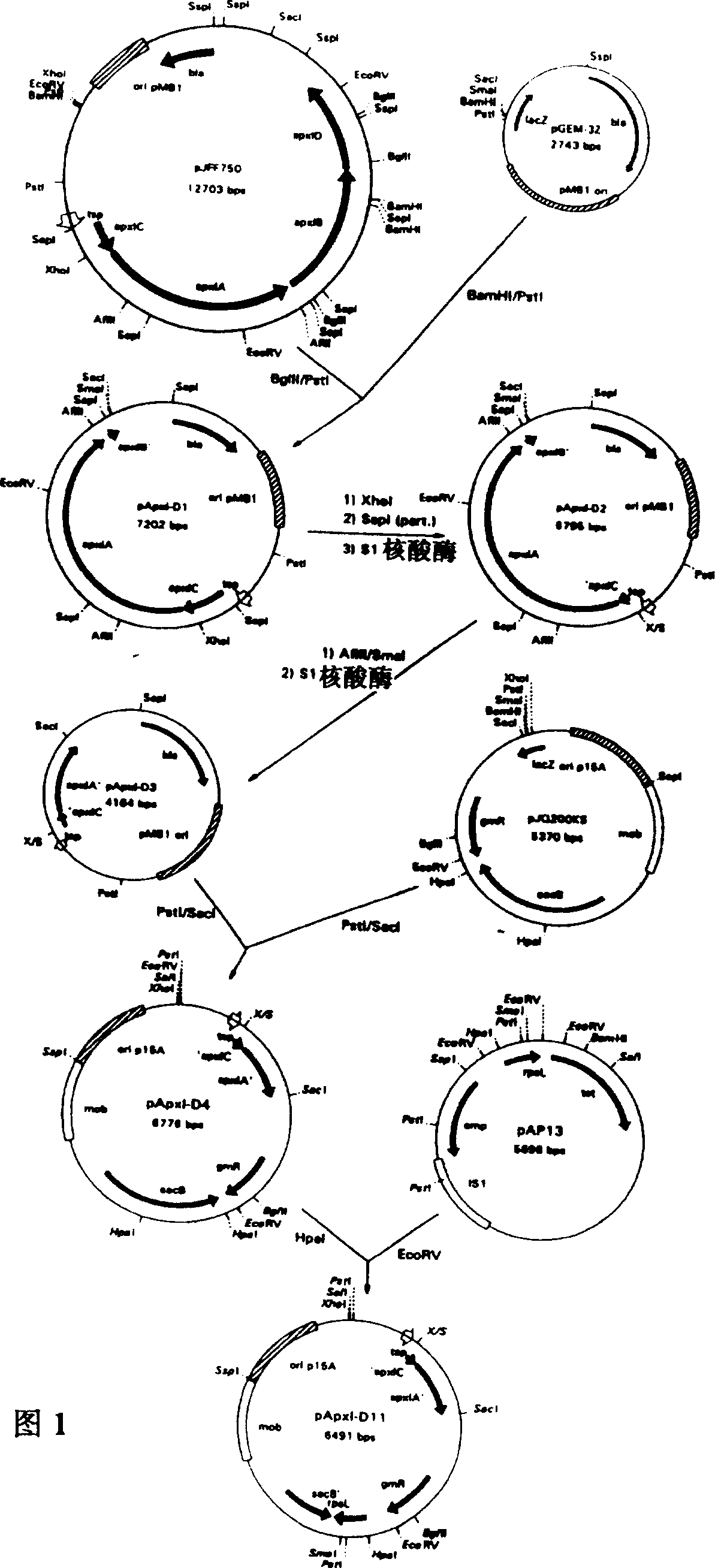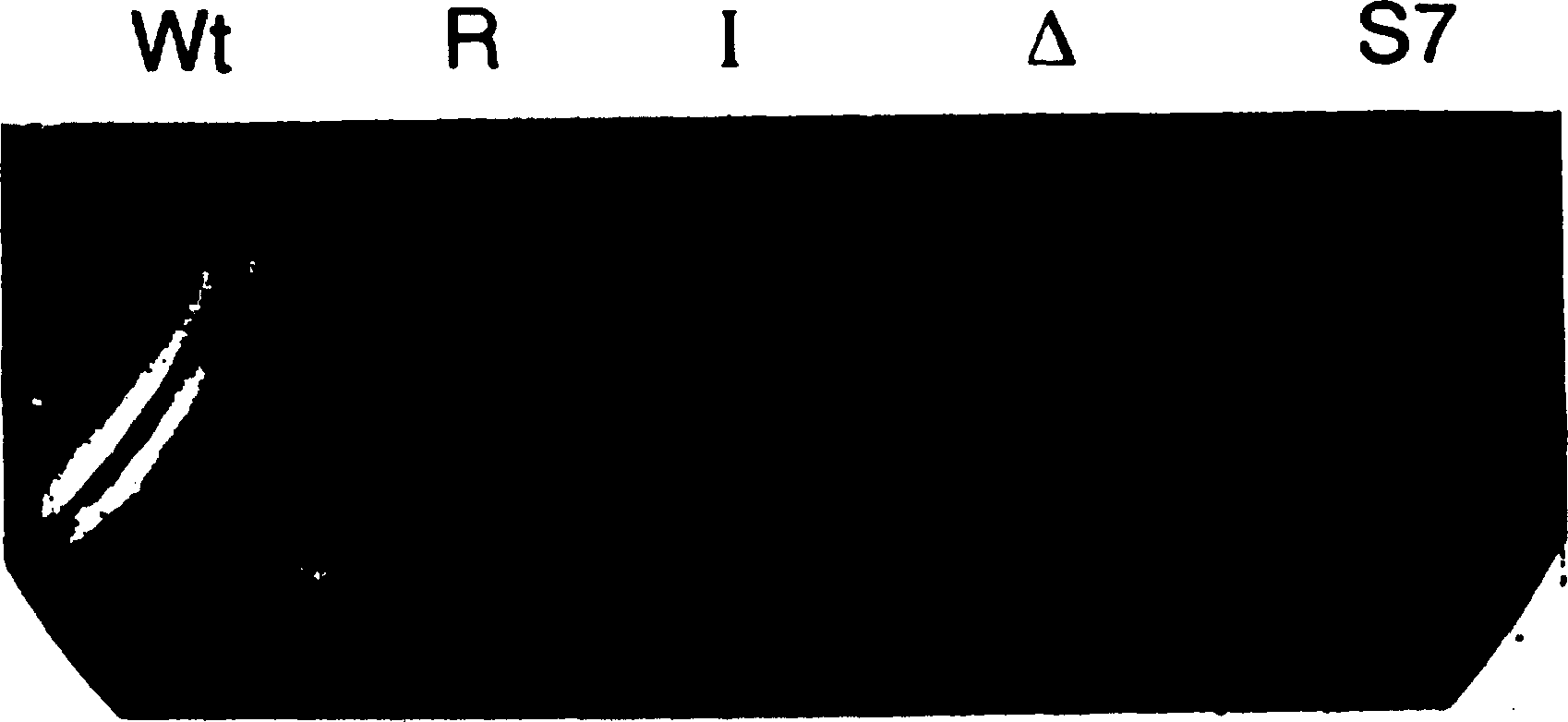Live attenuated RTX-producing bacteria of family pasteurellaceae
A Pasteurella, RTX- technology, applied in bacteria, methods of using bacteria, virus antigen components, etc., can solve problems such as undescribed and lack of vaccination experiments
- Summary
- Abstract
- Description
- Claims
- Application Information
AI Technical Summary
Problems solved by technology
Method used
Image
Examples
Embodiment Embodiment 1
[0093] Example Example 1: Preparation of live attenuated strains of Actinobacillus pleuropneumoniae. Construction of pApxI-D11:
[0094] The feasibility of the live attenuated bacteria according to the invention was demonstrated by the construction of the ΔapxIC mutant of Actinobacillus pleuropneumoniae.
[0095] To obtain this mutant, a plasmid including a deletion in the RTX-activator gene was first prepared.
[0096] The build outline is shown in Figure 1. The sequence of the apxI operon of Actinobacillus pleuropneumoniae is deposited in GenBank with the accession number X52899. From pJFF750 (Gygi et al.; Infection Immunity 60:3059-3064, 1992), the apxIC and apxIA genes and promoter regions were excised into a 4481 bp BglII / PstI fragment and cloned into plasmid pGEM3Z (Promega Co., Leiden NL) to BamHI and PstI digestion. The resulting plasmid was named pApxI-D1. A DNA fragment of 407 bp including most of the ApxIC coding region was excised by digestion with restricti...
Embodiment 2
[0102] Most importantly, it has been shown that the SspI / XhoI fragment including the apxIC gene is absent in MBHPP113 ( figure 2 , right group). Example 2:ΔapxIC mutant MBHPP113 tested for loss of RTX-toxin expression, secretion and hemolytic activity. Loss of hemolytic activity in the Actinobacillus pleuropneumoniae ΔapxIC mutant MBHPP113.
[0103] To demonstrate the deletion effect of ΔapxIC in MBHPP113, the hemolytic activity of the ΔapxIC strain MBHPP113 and the wild-type parent strain were compared after cultured on blood plates.
[0104] A reference strain of A. pleuropneumoniae belonging to serotype 7 (producing ApxII only) was also included for comparison.
[0105] Since ApxII has moderate hemolytic activity, this strain exhibits a moderate level of hemolysis.
[0106] Using a sterile toothpick, transfer a single colony to a Columbia agar plate containing (0.1% NAD and 2% sheep red blood cells. result:
[0107] as from image 3 As can be seen in , after 8 hou...
Embodiment 3
[0115] The experimental results in Example 2 prove that the Actinobacillus pleuropneumoniae MBHPP113 strain can indeed express and export the inactive form of RTX-toxin. Example 3: Construction of ΔapxICΔapx IIC mutant from Actinobacillus pleuropneumoniae strain 4074
[0116] Construction of the ΔapxIC mutation in strain 4074 was done as described in Example 1. Isolation of Actinobacillus pleuropneumoniae following incubation of a serotype 1 reference strain (Frey and Nicolet, J. Clin. Microbiol. 28:232-236, 1990) in the presence of streptomycin and subsequently in the presence of both streptomycin and nalidixic acid Recipient strain MBHPP104. Following conjugation of MBHPP104 to MBHP101 (described in Example 1), A. pleuropneumoniae resistant to nalidixic acid and gentamicin was obtained. After plating this strain on CBM plates containing 2% sheep erythrocytes, 0.1% NAD and nalidixic acid, several colonies with smaller hemolytic bands were identified. One of these coloni...
PUM
 Login to View More
Login to View More Abstract
Description
Claims
Application Information
 Login to View More
Login to View More - R&D
- Intellectual Property
- Life Sciences
- Materials
- Tech Scout
- Unparalleled Data Quality
- Higher Quality Content
- 60% Fewer Hallucinations
Browse by: Latest US Patents, China's latest patents, Technical Efficacy Thesaurus, Application Domain, Technology Topic, Popular Technical Reports.
© 2025 PatSnap. All rights reserved.Legal|Privacy policy|Modern Slavery Act Transparency Statement|Sitemap|About US| Contact US: help@patsnap.com



